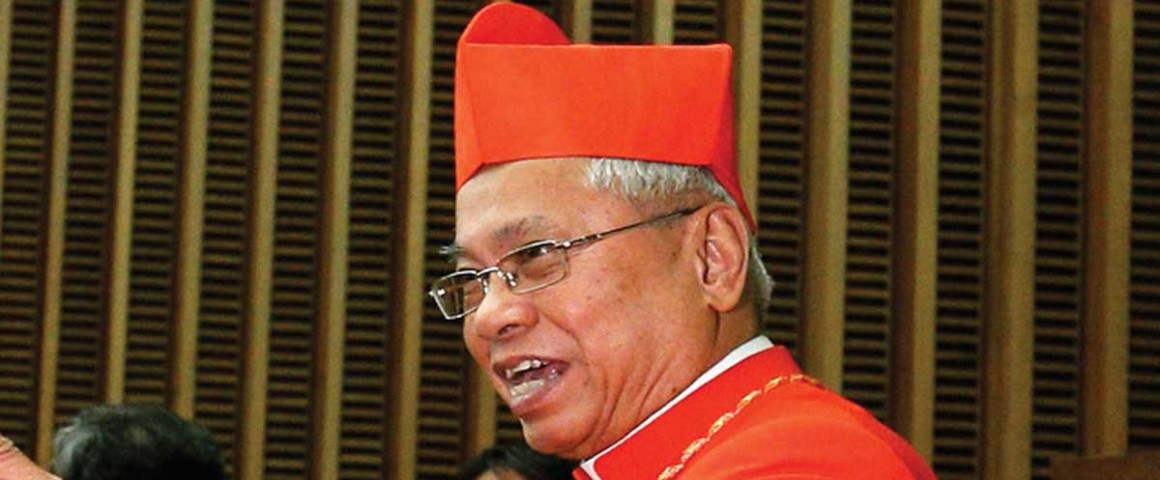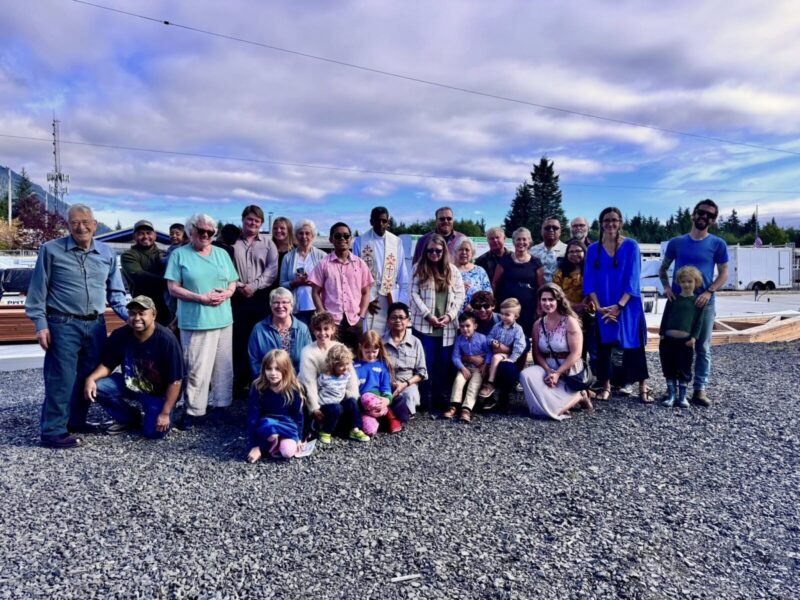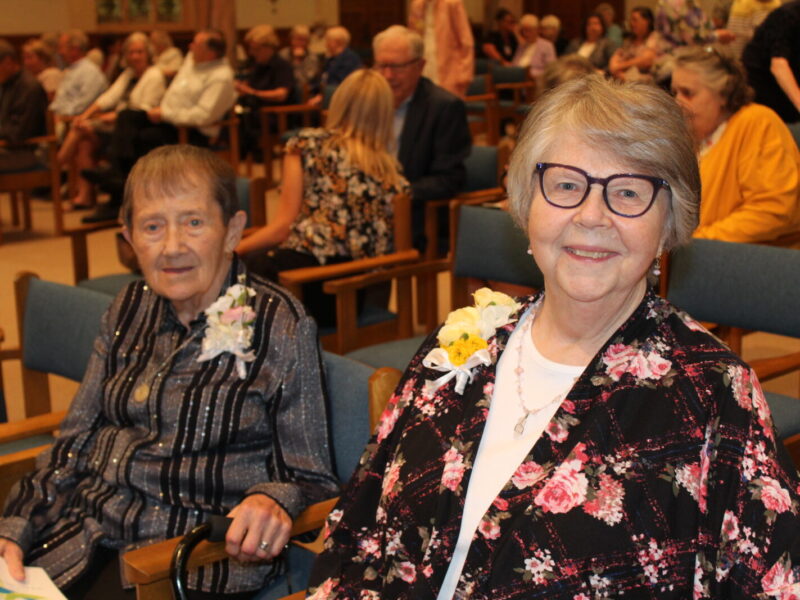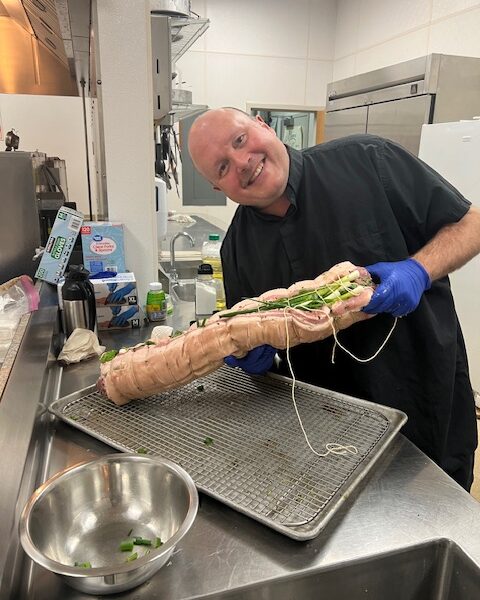 CatholicAnchor.org In early July Cardinal Orlando Quevedo, of the Archdiocese of Cotabato, Philippines, made his third visit to the Archdiocese of Anchorage and his first since Pope Francis made him a cardinal in February. The recent trip was part of the now decade-long Global Solidarity Partnership that Cardinal Quevedo and fellow Oblate of Mary Immaculate Anchorage Archbishop Roger Schwietz entered into in 2004. The arrangement, which seeks to build solidarity and friendships between Catholics in Alaska and the Philippines, has resulted in several priests from Cotabato coming to serve in Alaska over the years. In Alaska the cardinal checked in with his priest Father Jaime Mencias who is on loan and currently serving at St. Michael Church in Palmer. Later this year, Cardinal Quevedo expects to send a second priest to serve in the Archdiocese of Anchorage. While in Alaska, Cardinal Quevedo sat down with the Catholic Anchor to discuss the future of the partnership, his recent appointment as cardinal and the opportunities and challenges that come with this new responsibility. The following transcript was edited for length and clarity.
CatholicAnchor.org In early July Cardinal Orlando Quevedo, of the Archdiocese of Cotabato, Philippines, made his third visit to the Archdiocese of Anchorage and his first since Pope Francis made him a cardinal in February. The recent trip was part of the now decade-long Global Solidarity Partnership that Cardinal Quevedo and fellow Oblate of Mary Immaculate Anchorage Archbishop Roger Schwietz entered into in 2004. The arrangement, which seeks to build solidarity and friendships between Catholics in Alaska and the Philippines, has resulted in several priests from Cotabato coming to serve in Alaska over the years. In Alaska the cardinal checked in with his priest Father Jaime Mencias who is on loan and currently serving at St. Michael Church in Palmer. Later this year, Cardinal Quevedo expects to send a second priest to serve in the Archdiocese of Anchorage. While in Alaska, Cardinal Quevedo sat down with the Catholic Anchor to discuss the future of the partnership, his recent appointment as cardinal and the opportunities and challenges that come with this new responsibility. The following transcript was edited for length and clarity.
It’s been a decade now since you and Archbishop Schwietz agreed to start the Global Solidarity Partnership between your two dioceses. One of the great benefits for the Archdiocese of Anchorage has been having a number of Filipino priests serve in parts of Alaska that do not have priests. As you look forward, over the next 10 years of this partnership, do you see Cotabato continuing to send priests to Alaska?
CARDINAL QUEVEDO: I think it will be continuing, depending on the availability of priests.
When you last visited Alaska you said sending Filipino priests to serve here is like sending missionaries to a land that needs the Gospel. Is that still how you view it?
CARDINAL QUEVEDO: The mindset that I would like to establish among the priests who volunteer to serve in Alaska is that they are here on a mission from Cotabato to a place where priests are needed, where pastoral work is to be completed by priests. I don’t want them to come thinking they are coming to a greener pasture, financially or materially. No, I would like them to go and then return so that the priests will not be tempted to stay longer or transfer to another diocese. I want the priests to have that kind of mission. It’s a missionary life.
What do you see as the greatest blessing of this partnership for your diocese over the last 10 years?
CARDINAL QUEVEDO: For me, it’s the raising of mission consciousness among our people and among our priests. When we have prayers for missionaries, we now have people in mind — the Alaskans. And we have priests here. It’s something that is flesh and blood, rather than abstract.
Can you describe the moment when you found out that Pope Francis had named you to become a cardinal
CARDINAL QUEVEDO: At the noon angelus in Rome the pope gave the announcement. It was seven o’clock in the Philippines, and we were having dinner. My auxiliary bishop arrived late for dinner; he said, “Oh, someone told me that there’s a new cardinal from the Philippines, and he’s from Cotabato.” And I look at him and say, “No, no, that’s wrong — that’s wrong. He must be from Cebu.” And he stopped because he didn’t think that I would not know about it. I did not know about it. After dinner I looked at my cell phone. There were hundreds of messages. I saw the name of Cardinal Tagle of Manila — a message from him. So I opened that message, and it said, “Congratulations, you are our new cardinal.” I sent a message back to him saying, “You are congratulating the wrong person on the wrong island.” We expect that the archbishop of Cebu would take the place of the cardinal of Cebu and be made a cardinal, that’s what the expectation is, Manila and Cebu. But he sent back a message: “No, it’s you, it’s you!” I decided to look at the other messages. I thought first there were a lot of messages; I said, there must be a disaster somewhere. So many messages there must be a disaster somewhere. Maybe an earthquake again or some tsunami or some typhoon, flooding. But then I look at the other messages, it’s the same — messages from Asia, from Europe and one or two from America congratulating me. I said to myself, “This is a real disaster.” So people knew about it earlier than I did. I did not know. When the [papal] nuncio called up the following morning, I said, “Your Excellency, why did you not at least tell me one hour before so that I will not be caught.” The nuncio said, “But I did not know either.” I think it was a personal choice of the Holy Father.
What does the red hat mean to you?
CARDINAL QUEVEDO: It’s martyrdom. I was a reluctant bishop. I was a reluctant archbishop. And now I am a reluctant cardinal. It’s never my idea to go up higher and higher. I just wanted to be a simple Missionary Oblate and I tried to stay like that. The red hat for me is something like a daily dying to oneself. When the Holy Father gave me the red hat, I was kneeling in front of him and I said, “I shall serve in humility and simplicity.” That’s what I told him. It just came out. People wondered what the Holy Father and I talked about because it seemed that he spoke longer with me while kneeling down in front of him than with the other cardinals. He told me, “I will pray for peace in Mindanao. I will pray for good Muslim-Christian relationships.” The Holy Father is close to us, he remembers our problems. He will pray for us. And I told this to the Muslims also.
Did you ever get to know Cardinal Bergoglio before he became pope?
CARDINAL QUEVEDO: We worked together for four years (2001-2005) in Rome when we were both members of the Ordinary Council of the Secretariat of the Synod of Bishops. He was a new cardinal. In this council of 12, plus three appointed personally by the pope we gathered the documents of the synod to help the pope prepare his post-synodal exhortation. That first year, in 2001, we met at least three times.
So during those times you had a chance to talk with and get to know Cardinal Bergoglio?
CARDINAL QUEVEDO: Oh, yeah, yeah. I sort of gravitated toward him. He didn’t speak English very well but we could communicate. He is soft spoken.
You talked a little about being a reluctant bishop, a reluctant archbishop and a reluctant cardinal. But it seems like the pope is encouraging priests, bishops, cardinals, even himself — the pope — to not think of themselves as privileged but only as servers with more responsibilities.
CARDINAL QUEVEDO: Leaders in serving — I like that idea. As a bishop it has always been my guiding principle.
How does that impact Catholics and also non-Catholics, when they see the leaders of the church being servants?
CARDINAL QUEVEDO: There are two reactions. One is that they like seeing the leaders with the people. The other reaction is like one I experienced from the head of a Catholic organization in my archdiocese who said, “Archbishop, can you at least wear your episcopal robes once in a while so that the people will know you are the archbishop?” I said, “They know I am the archbishop, I don’t have to wear the robes.” “Yeah, but please, please maybe next Sunday, can you?” “Just to please her, I did that, but I don’t like to wear the robes.”
The media loves Pope Francis because he does these little things — carries his own bag, pays his own bill at the hotel, rides on the bus. He is with the people. I don’t know why the pope chooses certain people to be cardinals but it seems that he chose some because of the way they live out their faith with the people. Do you think that was a factor in your case?
CARDINAL QUEVEDO: People ask me, ‘Why were you chosen?’ I don’t know why I personally was chosen, but I think it is the place where I come from, the place where I come from is in the margins. It’s among Muslims, it is poor, and the Archdiocese of Cotabato is in the second most depressed area in the Philippines, second poorest area. And it is the place where conflicts between Muslims and Christians have taken place and are still taking place. It so happens that I am the archbishop there.
As a cardinal, and coming from an archdiocese where Islam and Christianity must coexist, how can these experiences help you contribute to finding solutions for the sometimes violent conflicts between Islam and Christianity around the world?
CARDINAL QUEVEDO: In the Philippines, people appreciate my work for peace. One of my works was identifying the root cause of the Muslim rebellion in the Philippines. The root cause is injustice — injustice to the Moro, the Moro identity, Moro sovereignty and Moro integral development. In peace talks, they seem to have been using that. And they ask me to intercede when there is an impasse in the negotiation. On the global level, the Holy Father has appointed me member of the Pontifical Council for Justice and Peace dealing with development and peace, poverty and all that. I have also been appointed as a member of the Pontifical Council for Interreligious Dialogue. It has been noticed that the focus there has been on the Middle East — relationships between Jews, Israelis, Palestinians, but also on the higher levels of interreligious dialogue between Islam and Christianity. But the council has not dealt very much with the Muslim-Christian relationships in Asia — in Malaysia, in Indonesia, in the Philippines, in parts of Thailand and in parts of India. I can inject a focus on the Asian part of that equation.
It’s difficult to think of these ongoing conflicts just in the Middle East, where there has been so much attention but very little progress towards peace. Then you mention all these other places that haven’t really seen the same focus. It makes one think we will never resolve these conflicts. But on the other hand, like you say in Cotabato, you must work in your land where your people are. You can’t just give up.
CARDINAL QUEVEDO: That’s right. There are burning churches in India, conflicts between Hindus, Muslims and Christians. In Indonesia, the burning of churches and killing of Christians and the rising fundamentalism in Malaysia. But in the Philippines, the Oblates have done great work. The Notre Dame schools there, high schools and colleges, have been very instrumental in building up Christian-Muslim relationships in a common life within the campus. Notre Dame University in Cotabato City — owned and run by the Oblates — is 60 percent Muslim and a Catholic university. It is a zone of peace. Everybody works together, plays together, everyone studies together, and sometimes, pray together and intermarry. And there are many of the leaders of the Moro Islamic Liberation Front and before that the Moro National Liberation Front who were graduates of Catholic high schools in Cotabato and Catholic colleges.





'Cardinal visits Alaska: Says leaders must serve'
Be the first to comment on this post!has no comments